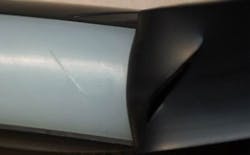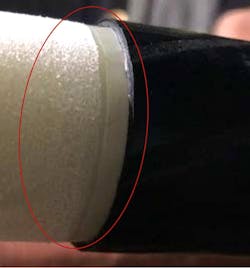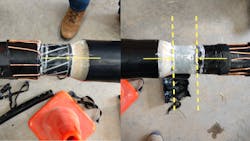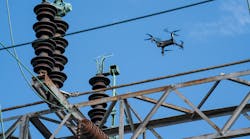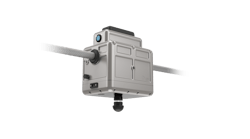PacifiCorp is the largest grid operator in the Western United States, serving the growing energy needs of two million customers while protecting the environment. It is a leader in providing safe, reliable, and sustainable low-cost power, developing innovative solutions and leveraging technology to make the grid more efficient, resilient, and secure. PacifiCorp has an impressive multi-state renewable generation portfolio. Its wind sites alone have the potential to provide approximately 2,300 MW of capacity through the operation of more than a thousand turbines.
In 2019, PacifiCorp was seeking help to determine the cause of several costly cable system failures at an existing wind generation site in Washington. The PacifiCorp renewable generation team learned about IMCORP’s work on the distribution side of the business and requested their assistance. Initially, PacifiCorp asked IMCORP to observe cable splice installations at one troubled site. IMCORP engineers quickly identified that workmanship issues were the root cause of the failures and cautioned PacifiCorp that observation alone could not identify the majority of issues. Since there are several blind steps in the installation process, they recommended an AI-based line scanning technology that could repeat the cable and accessory manufacturers’ quality control test to ensure cable system reliability of future projects.
PacifiCorp agreed with the recommendations and started to specify IMCORP’s cable scanning services to provide a foot-by-foot profile comparable to the cable and accessory manufacturers’ tests; offline 50/60Hz partial discharge (PD) test with 5 picoCoulomb (pC) sensitivity.
North American terminations, splices and cables are designed and quality-control tested using the parameters in the table on the facing page. In order to ensure design life performance, cable assets need to meet these standards in the field, and thus effective line scanning technology needs to produce a comparable result and is often specified using “offline 50/60Hz PD test with 5pC sensitivity.”
IMCORP provides medium and high voltage (5kV to 500kV) underground power cable reliability services for both new and aged cable system installations. Its technology can provide a foot-by-foot profile of cable systems, which identifies installation, factory, and age-related defects. IMCORP’s experience extends across hundreds of thousands of cable systems, thousands of dissections, and root cause analyses on cable system defects and failures. It has commissioned approximately 65% of all U.S. wind/solar sites, serving 40+ owner/developers across over 500 utility scale project sites.
Before engaging IMCORP, PacifiCorp employed a 0.1 Hz Very Low Frequency (VLF) test on their cable collector systems. VLF tests provide confidence that no existing grounds or shorts exist, but typically miss over 99% of defects as defined by manufacturers. Approximately 40% of new installations have at least one substandard component that will experience degradation during a VLF test but in most cases will not be detected, leaving the system vulnerable to failure and significant financial losses.
Cable system failures at renewable sites typically cost on the order of $100,000 in lost generation revenue and operating and maintenance (O&M). Cases have been documented up to a half million dollars in losses per failure, especially if the outage is associated with power purchase agreement (PPA) liabilities. Applying an offline 50/60Hz PD test with 5pC sensitivity typically costs less than 1% of the average utility-scale project, can yield a return on investment (ROI) on the order of 15x, and is essentially a low-cost reliability insurance.
PacifiCorp has used both VLF tests and the IMCORP AI-based offline 50/60Hz PD test at multiple sites, offering side-by-side comparisons of the two approaches. The following case studies are two examples.
PacifiCorp Case Study 1 -Wyoming
In 2020, PacifiCorp was commissioning a new wind generation site in Wyoming, where it employed both the IMCORP line scanning technology and VLF tests. Over 100 miles of cable including more than 300 splices and 700 terminations were installed and commissioned using 0.1Hz VLF tests. All cable systems passed the test with no defects/failures identified. On the basis of the previously mentioned consulting work, PacifiCorp was particularly concerned with circuits containing splices and directed its construction team to test circuits using IMCORP’s cable scanning technology. More than 50 splice, termination, and cable insulation defects missed by VLF tests were detected. All the defects were repaired and retested to ensure the final condition met the cable and accessory manufacturers’ standards.
Some defect samples were extracted and sent to the IMCORP root cause analysis laboratory, where it was determined the root cause of the cable defects was manufacturing errors, whereas the root cause of the substandard accessories was installation error.
These findings only underscored the value of using factory comparable cable scanning technology capable of detecting defects before failure, with all the evidence intact. Both the field and laboratory dissections provided PacifiCorp and its contractors with an accelerated constructive feedback loop on the cable system product selection, design and installation quality. Energizing a system with defective components can lead to costly failures and collector system downtime, both in the short and long term of the system’s life. Due to these results, PacifiCorp has enforced its offline 50/60Hz PD test with 5pC sensitivity specification to commission its medium-voltage feeder systems. PacifiCorp has experienced no failures at this this site since energization.
PacifiCorp Case Study 2 - Wyoming
In the second case study, three sites of similar scale (A, B, and C) were built to the same specifications using the same design, components, and installers. VLF tests were conducted on Sites B and C, including more than 120 miles of cable systems, and no defects were detected. PacifiCorp purchased Site A from the developer and specified an offline 50/60Hz test with 5pC sensitivity to commission nearly 66 miles. The cable scanning technology located hundreds of defects, including 32% of the site’s splices. At first the installers were in a state of disbelief that all the splices passed on Sites B & C and so many splices did not meet the manufacturer’s minimum performance requirements (IEEE 404) on Site A. An onsite dissection and root cause analysis showed that installation errors were the cause of the substandard performance. The onsite dissection allowed the installers to be re-trained and coached on the proper installation. To demonstrate the splices could be installed to manufacturers’ standards, a control splice was installed under supervision, and a subsequent test demonstrated that it easily surpassed the manufacturers’ performance expectations.
After repair or replacement, Site A’s substandard components were retested proving they now met manufacturers’ standards. The ability to use IMCORP’s cable scanning technology during commissioning provided a valuable feedback loop to installers and proved to be an invaluable training tool to correct and improve craftwork in real time.
Site A, commissioned by IMCORP, experienced no failures post-commissioning but sites B & C, commissioned with a VLF test, incurred 14 failures on splices. Over the operations period, this equates to a failure rate of 5.3 failures/100 miles/year. The cost of each failure in O&M and revenue losses was estimated at over $100,000, bringing the total impact to over the million-dollar mark.
Conclusion
Armed with the knowledge that over 90% of cable failures are a result of issues that are preexisting or introduced at the time of cable system installation, as well as understanding that not all cable testing is equal, PacifiCorp now specifies offline 50/60Hz PD testing with 5pC sensitivity to commission all medium-voltage feeder cable systems.
Nathan Etzel ([email protected]) is a renewable SCADA and electrical engineer (dev & O&M) for PacifiCorp. He has been in the electrical industry for over a decade and has an electrical and computer engineering degree from Oregon State University.
Dave Modos ([email protected]) is IMCORP’s renewable market senior vice president. Prior to IMCORP, Modos worked in business development, sales, and marketing management at Eaton Corporation. He holds a bachelor’s degree in business administration from Santa Clara University.


